Related Research Articles

Mary Hunter Austin was an American writer. One of the early nature writers of the American Southwest, her classic The Land of Little Rain (1903) describes the fauna, flora, and people – as well as evoking the mysticism and spirituality – of the region between the High Sierra and the Mojave Desert of southern California.
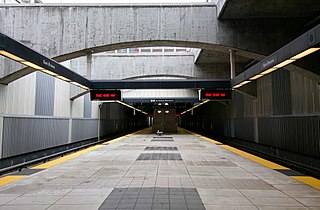
San Bruno station is a Bay Area Rapid Transit (BART) station located adjacent to the Tanforan shopping center in San Bruno, California in northern San Mateo County. It consists of two main tracks and a shared underground island platform. Service at the station began on June 22, 2003 as part of the BART San Mateo County Extension project that extended BART service southward from Colma to Millbrae and San Francisco International Airport. The station is served by the Red and Yellow lines.
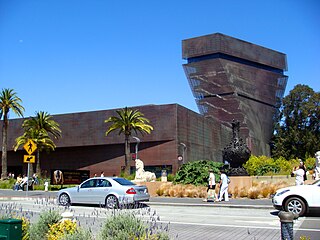
The de Young Museum, formally the M. H. de Young Memorial Museum, is a fine arts museum located in San Francisco, California. Located in Golden Gate Park, it is a component of the Fine Arts Museums of San Francisco, along with the Legion of Honor. The de Young is named for early San Francisco newspaperman M. H. de Young.

The Topaz War Relocation Center, also known as the Central Utah Relocation Center (Topaz) and briefly as the Abraham Relocation Center, was an American concentration camp in which Americans of Japanese descent and immigrants who had come to the United States from Japan, called Nikkeiwere incarcerated. President Franklin Roosevelt signed Executive Order 9066 in February 1942, ordering people of Japanese ancestry to be incarcerated in what were euphemistically called "relocation centers" like Topaz during World War II. Most of the people incarcerated at Topaz came from the Tanforan Assembly Center and previously lived in the San Francisco Bay Area. The camp was opened in September 1942 and closed in October 1945.

Yvonne Helene Jacquette was an American painter, printmaker, and educator. She was known in particular for her depictions of aerial landscapes, especially her low-altitude and oblique aerial views of cities or towns, often painted using a distinctive, pointillistic technique. Through her marriage with Rudy Burckhardt, she was a member of the Burckhardt family by marriage. Her son is Tom Burckhardt.
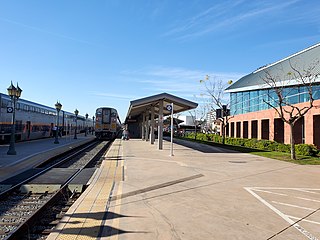
Bakersfield station is an intermodal facility in Bakersfield, California. It is the southern terminus of Amtrak California's San Joaquins route, with Amtrak Thruway buses continuing to Amtrak stations and bus stops throughout Southern California and Nevada. The station opened with a celebration on July 4, 2000. It contains an 8,300-square-foot (770 m2) train station with two platforms and three tracks, as well as a 17-bay bus station.
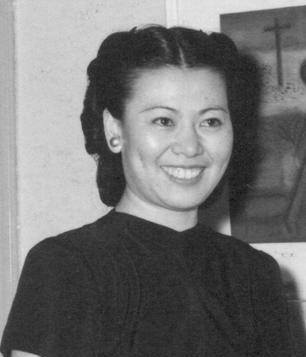
Miné Okubo was an American artist and writer. She is best known for her book Citizen 13660, a collection of 198 drawings and accompanying text chronicling her experiences in Japanese American internment camps during World War II.

Linda Lomahaftewa is a Hopi and Choctaw printmaker, painter, and educator living in Santa Fe, New Mexico.

The Tanforan Assembly Center was created to temporarily detain nearly 8,000 Japanese Americans, mostly from the San Francisco Bay Area, under the auspices of Executive Order 9066. After the order was signed in February 1942, the Wartime Civil Control Administration acquired Tanforan Racetrack on April 4 for use as a temporary assembly center; plans called for the site to be used to accommodate up to 10,000 "evacuees" while permanent relocation sites were being prepared further inland. The Tanforan Assembly Center began operation in late April 1942, the first stop for thousands who were forced to relocate and undergo internment during World War II. The majority were U.S. citizens of Japanese ancestry who were born in the United States. Tanforan Assembly Center was operated for slightly less than six months; most detainees at Tanforan were transferred to the Topaz War Relocation Center in Utah, starting in September. The transfer to Topaz was completed by mid-October, and the site was turned over to the Army a few weeks later.
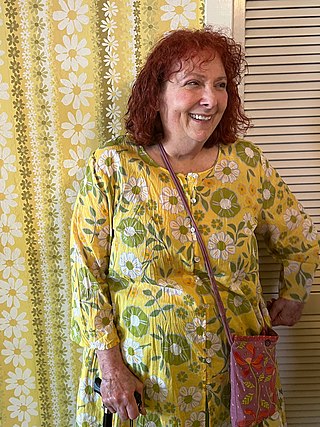
Nancy Youdelman is a mixed media sculptor who lives and works in Clovis, California. She also taught art at California State University, Fresno from 1999 until her retirement in 2013. "Since the early 1970s Youdelman has been transforming clothing into sculpture, combining women's and girl's dresses, hats, gloves, shoes, and undergarments with a variety of organic materials and common household objects.
Shizu Saldamando, is an American visual artist. Her work merges painting and collage in portraits that often deal with social constructs of identity and subcultures. Saldamando also works in video, installation and performance art. She has been featured in numerous exhibitions, has attained accolades like that of Wanlass Artist in Residence, and is a successful writer, tattoo artist, and social activist.

Hisako Shimizu Hibi (1907–1991) was a Japanese-born American Issei painter and printmaker. Hibi attended the California School of Fine Arts in San Francisco, California where she garnered experience and recognition in the fine arts and community art-exhibition. Here, she met her husband George Matsusaburo Hibi, with whom she raised two children, Satoshi "Tommy" Hibi and Ibuki Hibi.
Alice Geneva "Gene" Kloss was an American artist known today primarily for her many prints of the Western landscape and ceremonies of the Pueblo people she drew entirely from memory.
Betty Nobue Kano is a Japanese painter, curator and lecturer at San Francisco State University and New College of California, teaching the 332 Japanese American Art and Literature class. She is notable for exhibiting her work in nearly 200 regional, national and international galleries and museums, including the Museum of Modern Art in San Francisco.

Shaghayegh Cyrous (Persian: شقایق سیروس; is an American artist and curator based in Los Angeles. Her interactive time-based investigations, participatory projects, and video installations have been said to "create a poetic space for human connections."
Raheleh "Minoosh" Zomorodinia is an Iranian-born American interdisciplinary visual artist, curator, and educator. She works in many mediums, including in photography, video, installation, and performance. Her work is informed by the tension between Iran and the United States, as well as explorations of the self, of home, nature, and the environment. She is based in the San Francisco Bay Area.
Koho Yamamoto is an American artist known for her artistry in Sumi-e, a style of Japanese brushwork using black ink. She is also a poet, calligrapher, and a teacher. She uses her experiences from the American concertation camps to create beautiful abstract art. "My painting comes from nothingness and has right to it," Koho States in an interview. One of her most memorable experiences was meeting her teacher in one of the concentration camps.
Taneyuki “Dan” Harada was a Japanese-American painter and computer scientist who was incarcerated at Tanforan Assembly Center, Topaz War Relocation Center, Leupp Isolation Center, and Tule Lake Segregation Center during World War II. His paintings capture the experience of Japanese-Americans in concentration camp life, including the segregation, isolation, and discrimination they faced. He learned to paint at various art schools while detained, and continued studying at the California College of Arts and Crafts in Oakland, California after being released at the end of the war. He was the recipient of the James D. Phelan Art Award, established to recognize the achievements of California-born artists across many disciplines, in 1949. Today, pieces of his collections are held at the San Francisco Fine Art Museum, the Autry Museum of Western Heritage, and the Los Angeles County Museum of Art
References
- 1 2 3 Art, Monterey Museum of. "Shadows from the Past: Sansei Artists and the American..." Monterey Museum of Art. Retrieved 2023-11-09.
- 1 2 "Na Omi Judy Shintani". members.aawaa.net. Retrieved 2023-11-09.
- ↑ "Judy Shintani". Women Eco Artists Dialog. Retrieved 2023-11-09.
- ↑ "Current NCWCA Members". Northern California Women's Caucus for Art. Retrieved 2023-11-09.
- ↑ "Sansei Granddaughters' Journey". Sansei Granddaughters' Journey. Retrieved 2023-11-09.
- ↑ Wylde, Nanette, ed. (2022). Entanglements: a curated collection of contemporary culture. Redwood City, California: PreNeo Press. pp. 24–35. ISBN 978-1-936083-20-6.
- 1 2 "Na Omi Judy Shintani". Santa Fe Art Institute. Retrieved 2021-11-30.
- ↑ "Home | San Francisco | Judy Shintani". judyshintaniart. Retrieved 2021-11-30.
- 1 2 3 "Na Omi Judy Shintani". San Joaquin Delta College. 2021-01-20. Retrieved 2021-11-30.
- 1 2 "Na Omi Judy Shintani". members.aawaa.net. Retrieved 2021-11-30.
- 1 2 3 4 "Springfield College Hosts Artist Judy Shintani | Springfield College". springfield.edu. 21 September 2017. Retrieved 2021-11-30.
- ↑ "Shadows from the Past: Sansei Artists and the American Concentration Camps". San Joaquin Delta College. 2021-01-19. Retrieved 2023-11-09.
- ↑ "L.H. Horton Jr. Gallery presents 'The New Domestics'". San Joaquin Delta College. 2019-03-01. Retrieved 2023-11-09.
- 1 2 "Art of Resilience and Identity | Peninsula Museum of Art". www.peninsulamuseum.org. Retrieved 2023-11-09.
- 1 2 3 "Judy Shintani on Asian Pacific America". NBC Bay Area. Retrieved 2021-12-12.
- ↑ "Tanforan Memorial & Exhibit | Bay Area Rapid Transit". www.bart.gov. Retrieved 2023-11-09.
- ↑ "Reporters' notebook". San Mateo Daily Journal. 2012-12-21. Retrieved 2023-11-09.
- ↑ "Peninsula Arts Council Announces Diamond Award Recipients". Half Moon Bay, CA Patch. 2012-12-19. Retrieved 2023-11-09.
- ↑ "Na Omi Judy Shintani". Santa Fe Art Institute. Retrieved 2023-11-09.
- ↑ "'Break the Silence: Sharing Stories on Mental Health and Healing Through the Arts'". San Joaquin Delta College. 2019-01-14. Retrieved 2023-11-09.
- ↑ "California Arts Council Individual Artists Fellowship Program (CAC IAF) Central California Region Individual Artists Fellows". SVCREATES. Retrieved 2023-11-09.